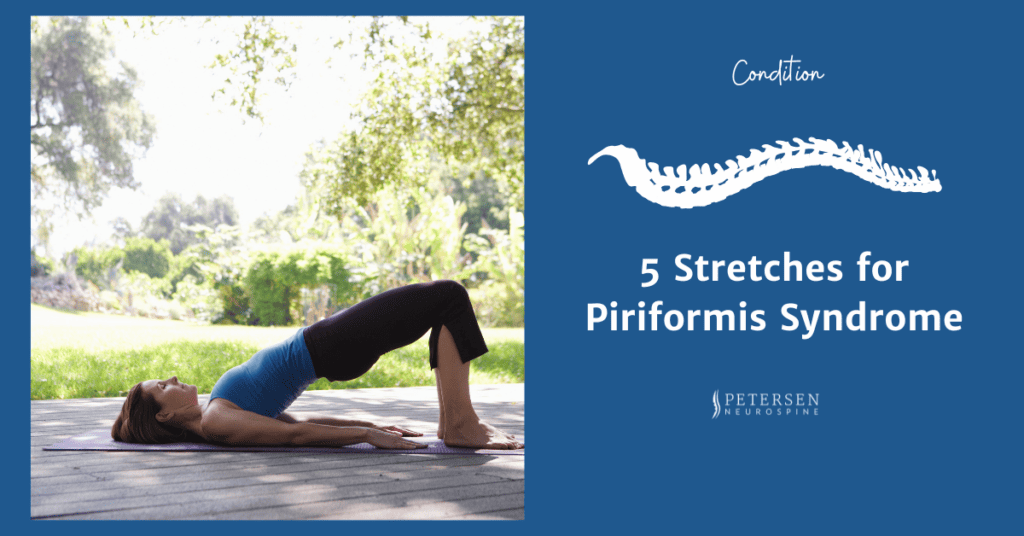
Piriformis syndrome occurs when the piriformis muscle in the buttock compresses the sciatic nerve, resulting in inflammation, lower back pain and numbness. While not as common as sciatica, this syndrome can still be extremely painful and debilitating, especially if left untreated.
If you’re experiencing piriformis syndrome or lower back pain, we suggest consulting a spine specialist. While you’re waiting for an appointment or if you’re currently undergoing treatment, here are five stretches and exercises you can do at home to help alleviate your pain.
Bridge Pose
One of the easiest and most accessible stretches for piriformis syndrome is bridge pose. To do this pose, lie flat on your back, bend your knees and lift your hips and glutes up towards the sky. Once you’re at full extension, squeeze your glutes and lower slowly back to the floor. Repeat this 10 times per set. We recommend completing 2-3 sets. If this motion is too intense, roll up a blanket or towel to place underneath your lower back. Hold that static pose for 30-60 minutes and repeat 2-3 times.
Ankle-over-knee Glute Stretch
Also known as the figure-4 stretch, the ankle-over-knee glute stretch requires you to lay flat on your back and bend both knees — a great follow-up to bridge pose. You will then cross one ankle over the opposite knee and pull your knee into your chest by grabbing your hamstring. Relax into this pose for about 30-60 seconds, release and switch sides. We recommend repeating that 2-3 times per side for maximum relief. This pose is also often used to relieve sciatica.
Walking
Wanting to spend some time off the floor? Head out for a walk! Walking is a fantastic, low-impact way to relieve pain from piriformis syndrome. It can help strengthen your piriformis muscle while also reducing muscle tightness and spasms. If you’re beginning a new walking routine, take it slow! Start with a distance or time you feel comfortable with, then build from there.
Plank & Side Plank
Alleviating pain and healing from piriformis syndrome requires strengthening your core, which includes your back, hamstrings, hip flexors and, of course, your abdominal muscles. Planks and side planks are a great way to do just that!
To get into a plank, lie flat on your stomach resting on your forearms. Using strength in your legs, lift your hips off the floor, forming a straight line from the crown of your head to your heels. If you’re new to exercising, try holding this pose for 15 seconds. Repeat three times. We recommend working up to a 30-second or minute-long hold.
To get into a side plank, lie on one side of your body resting on your forearm. Use your legs to lift your hips off the floor, forming a straight line from your ear to your ankle. If you’re new to exercising, try holding this pose for 15 seconds. Repeat three times on both sides. Like plank pose, we recommend working up to a 30-second or minute-long hold.
Narrow Squats
Another wonderful core- and glute-strengthening exercise is the narrow squat. Begin with your feet about a hips width apart then lower your hips as if you’re sitting in a chair. Squat as far as you’re comfortable, aiming to get your hips parallel to your knees. Repeat this 10 times per set and complete 2-3 sets.
Each of these exercises can be completed at home or at a local gym. Our physicians recommend doing the stretches and strengthening exercises 1-2 times per day. As for walking, it’s recommended that adults get 150 minutes of aerobic exercise per week. Aim to get close to that to start and see how your piriformis syndrome improves after a few weeks.
As always, if you have any questions, please reach out to our office by calling 251-607-6117.

